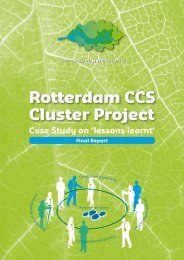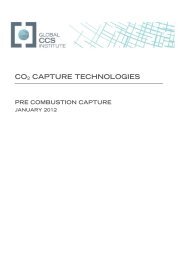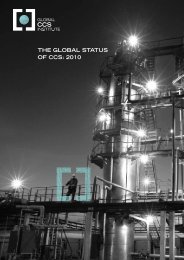Perceptions of CO2 Report - Global CCS Institute
Perceptions of CO2 Report - Global CCS Institute
Perceptions of CO2 Report - Global CCS Institute
- No tags were found...
You also want an ePaper? Increase the reach of your titles
YUMPU automatically turns print PDFs into web optimized ePapers that Google loves.
2.2 <strong>Perceptions</strong> <strong>of</strong> CO 2Very little existing research literature describes the general public’s perceptions <strong>of</strong> CO 2 . Researchinto public understanding and perceptions <strong>of</strong> climate change and energy technologies have onlyexamined individual knowledge and perceptions <strong>of</strong> CO 2 as a secondary focus, if at all. However,these studies have demonstrated that substantial gaps exist in the general public’s knowledge andunderstanding <strong>of</strong> CO 2 . For example, interviews conducted by Wallquist, Visschers, and colleagues(2009) demonstrated a lack <strong>of</strong> knowledge on the physical-chemical properties <strong>of</strong> CO 2 among the‘lay’ (i.e. non-scientific) population. Misconceptions were particularly evident with regards todispersion rates <strong>of</strong> CO 2 in the atmosphere and its density in a super-critical state and in solution(Wallquist, et al., 2009).In addition to CO 2 ’s chemical properties, its sources and the environmental problems it causes alsoremain a source <strong>of</strong> confusion for members <strong>of</strong> the general public (Curry, Reiner, Ansolabehere, &Herzog, 2005; Sharp, Jaccard, & Keith, 2009). An early cross-national public opinion study usingsurveys delivered in the USA, UK, Sweden and Japan found that respondents had difficultyassociating CO 2 with global warming as opposed to other environmental problems, such as ozonedepletion (Reiner, et al., 2006b). However, when asked to identify the sources and sinks <strong>of</strong> CO 2 ,the majority <strong>of</strong> respondents in all countries correctly identified cars, coal-fired power plants, andhome heating as causes for increasing levels <strong>of</strong> CO 2 . Likewise, almost all <strong>of</strong> the respondentsunderstood the underpinnings <strong>of</strong> photosynthesis in plants, correctly responding that trees could bea sink to reduce atmospheric CO 2 levels. In a replication <strong>of</strong> that survey in Australia and the UK in2006, the results were almost identical (Ashworth, Reiner, Gardner, & Littleboy, 2007).Many laypeople are unfamiliar with the mechanisms by which climate change takes place. In theironline survey <strong>of</strong> the Australian public, Ashworth, Jeanneret and colleagues (2011b) found that half<strong>of</strong> respondents incorrectly identified ozone depletion as a cause <strong>of</strong> climate change; and only justover half understood the mechanism <strong>of</strong> the greenhouse effect. Similarly, de Best-Waldhober,Daamen and colleagues (2009) found that the majority <strong>of</strong> respondents in the Netherlands wereunable to identify the relationship between fossil fuel use, CO 2 , and global warming.Even today, laypeople commonly misperceive and misunderstand CO 2 . A recent study <strong>of</strong> theDutch general public by Paukovic and colleagues (2011), which measured CO 2 knowledge,suggests that incorrect beliefs and uncertainty about the properties <strong>of</strong> CO 2 are still prevalent. Forexample, 25.2% <strong>of</strong> respondents thought or were convinced that people do not exhale CO 2 ; and22.4% were unsure about the validity <strong>of</strong> this claim. Similarly 20.7% thought that CO 2 causescancer, and 38.4% were unsure whether this was the case or not.Likewise, recent survey research conducted in the UK by Whitmarsh, Seyfang and colleagues(2011) suggests that knowledge about “carbon” is still limited, even while the causes <strong>of</strong> climatechange are increasingly recognised. The UK survey found that carbon was most commonlyconceptualised as meaning ‘CO 2 ’; consequently, it was perceived negatively as harmful, toxic, andan anthropogenic source <strong>of</strong> climate change, rather than a naturally occurring and abundantbuilding block <strong>of</strong> life (Whitmarsh, et al., 2011).These varying misperceptions about CO 2 and associated concepts such as carbon have follow-oneffects for peoples’ understanding and perceptions <strong>of</strong> the mitigation techniques (such as <strong>CCS</strong>)required to address the problems associated with greenhouse gas (GHG) emissions.4 | Understanding how individuals perceive carbon dioxide
















